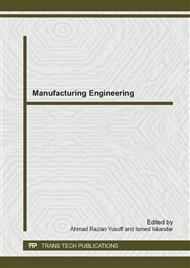[1]
H. B. Maynard, Industrial engineering handbook vol. 1: McGraw-Hill New York, (1963).
Google Scholar
[2]
A. P. Sage, Decision support systems: Wiley Online Library, (2007).
Google Scholar
[3]
E. H. Kaplan, OR Forum—Intelligence Operations Research: The 2010 Philip McCord Morse Lecture, Operations Research, (2012).
DOI: 10.1287/opre.1120.1059
Google Scholar
[4]
T. Eguchi, H. Ooguri, and Y. Tachikawa, Notes on the K3 Surface and the Mathieu group M 24, Experimental Mathematics, vol. 20, pp.91-96, (2011).
DOI: 10.1080/10586458.2011.544585
Google Scholar
[5]
C. H. Heidelbaugh, Examination of National Policy to Build Partner Capacity, DTIC Document2012.
Google Scholar
[6]
H. A. Taha and H. Taha, Operations research: an introduction vol. 8: Prentice hall Upper Saddle River, NJ, (1997).
Google Scholar
[7]
A. Amindoust, S. Ahmed, and S. Ketabi, Evaluation and selection of supplier in supply chain network based on DEA, in The 11th Asia Pacific Industrial Engineering and Management Systems Conference, 2010, pp.1-6.
Google Scholar
[8]
A. Amindoust, S. Ahmed, and A. Saghafinia, Location decision of supply chain management in the auto motive industry, International Journal of Engineering, vol. 1, pp.2305-8269, (2012).
Google Scholar
[9]
A. Amindoust, S. Ahmed, and A. Saghafinia, Using Data Envelopment Analysis for Green Supplier Selection in Manufacturing under Vague Environment, Advanced Materials Research, vol. 622, pp.1682-1685, (2013).
DOI: 10.4028/www.scientific.net/amr.622-623.1682
Google Scholar
[10]
A. Amindoust, S. Ahmed, and A. Saghafinia, Supplier Selection and Performance Evaluation of Telecommunication Company, American Journal of Engineering and Applied Sciences, vol. 5.
Google Scholar
[11]
A. Charnes, W. W. Cooper, and E. Rhodes, Measuring the efficiency of decision-making units, European Journal of Operations Research, vol. 2, pp.429-444, (1978).
DOI: 10.1016/0377-2217(78)90138-8
Google Scholar
[12]
N. Adler, L. Friedman, and Z. Sinuany-Stern, Review of ranking methods in the data envelopment analysis context, European Journal of Operational Research, vol. 140, pp.249-265, (2002).
DOI: 10.1016/s0377-2217(02)00068-1
Google Scholar
[13]
L. M. Seiford and R. M. Thrall, Recent developments in DEA: the mathematical programming approach to frontier analysis, Journal of econometrics, vol. 46, pp.7-38, (1990).
DOI: 10.1016/0304-4076(90)90045-u
Google Scholar
[14]
R. S. Barr, DEA software tools and technology, Handbook on data envelopment analysis, pp.539-566, (2004).
Google Scholar
[15]
J. Zhu, Quantitative models for performance evaluation and benchmarking: data envelopment analysis with spreadsheets and DEA excel solver vol. 51: Kluwer Academic Pub, (2003).
DOI: 10.1007/978-1-4757-4246-6_12
Google Scholar


